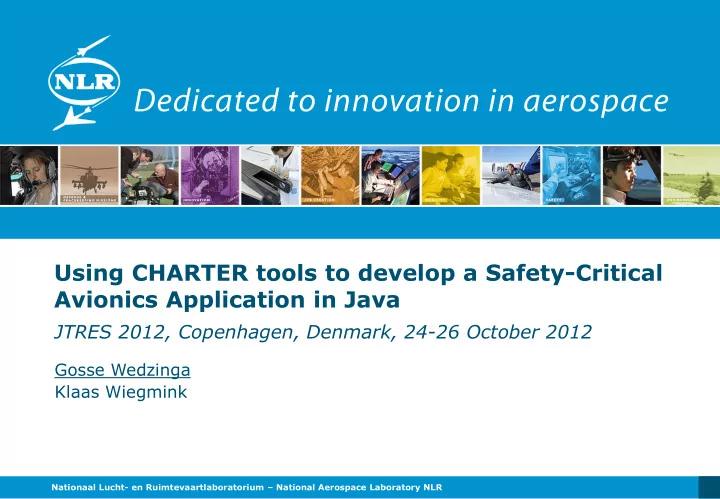

Using CHARTER tools to develop a Safety-Critical Avionics Application in Java JTRES 2012, Copenhagen, Denmark, 24-26 October 2012 Gosse Wedzinga Klaas Wiegmink Nationaal Lucht- en Ruimtevaartlaboratorium – National Aerospace Laboratory NLR
Outline Avionics systems & challenges Increasing role of software Architectural evolution Certification aspects of avionics software CHARTER approach Overview CHARTER software life-cycle Evaluation of CHARTER approach Tools evaluated Safety-critical avionics application Assessment Concluding remarks 2
Avionics systems Avionics literally means “aviation electronics” Comprises all electronic systems designed for use on an aircraft, artificial satellites, and spacecraft An avionics system is safety-critical when its failure could result in loss of life or significant damage Present day avionics systems are increasingly based on computers and many functions are realized in software 3
Architectural evolution Federated architecture Integrated Modular Avionics One computer system for One computer system for each unique function multiple distinct functions Line Replaceable Units (LRU’s) Generic processing modules Unique combination of hardware Independence between application and software and execution platform Dedicated interconnections Packet-switched network Point to (multi)point Virtual links Intrinsic functional isolation Functional isolation provided by time & memory partitioning Application Application Application I F V Network N M H OS S S F Hardware 4
Architectural evolution Impact of IMA Advantages Reduced space, weight, and power (SWaP) Application portability – Independent component development (applications, modules) – Reduced obsolescence issues Reduced spares inventory ... Challenges Integration responsibility IPR issues – Multiple suppliers on one platform Complexity of configuration – Tables define resource allocation to applications 5
Certification aspects of avionics software EUROCAE document ED-12: Software Considerations in Airborne Systems and Equipment Certification Guidance for production of software for airborne systems – Objectives of software life-cycle processes – Activities for satisfying the objectives – Descriptions of the compliance evidence Emphasis on development assurance – Requirements-based development – Verification (incl. testing) Increasing effort with increasing software level – Software level is input from system safety assessment Revision C (January 2012) New supplements, e.g., object-oriented technologies, model-based development, formal verification 6
Certification aspects of avionics software ED-12 Software levels Aircraft failure Level Meaning condition A Catastrophic Loss of airplane, multiple fatalities Damage to airplane, excessive workload, B Hazardous some passengers injured (incl. fatal) Reduction in airplane capabilities, C Major increased workload, passengers distressed/injured Little effect on operation of airplane and D Minor crew workload, some physical discomfort No effect on operation of airplane or crew E No effect workload 7
CHARTER approach Critical and High Assurance Requirements Transformed through Engineering Rigour 2009 - 2012 8
CHARTER project overview Goal Improve software development process for safety-critical embedded systems: reducing cost & increasing quality Approach Apply model-based development Use as programming language Real-Time Java augmented with Java Modeling Language (JML) specifications Apply Rule-Driven Transformation (RDT) technique Transform UML model elements into Java source code Transform bytecode into machine code Potentially certifiable Provide tools for formal verification and automated test case generation 9
CHARTER software life-cycle Software Development Software Software Software Integration Requirements Design Coding Artisan Artisan Code JamaicaVM Tools javac Studio Studio Generator Builder Software Verification Software Reviews & Analyses Software Testing Tools ResAna KeYFloat VerCors KeYTestGen JUnit 10
Evaluation of CHARTER approach Tool Activity Evaluated Artisan Studio Code Generator Add-in Coding JamaicaVM Builder Building * Loop bound analysis ResAna Heap consumption analysis Stack size analysis - Verification of concurrent data VerCors - structures KeYFloat Analysis of floating point computations - KeYTestGen Test case generation * Machine code generator was implemented for the ARM architecture 11
Safety-critical avionics application Environmental Control System (ECS) ECS Plant Air Air Conditioning Conditioning Zone Panel Page Zone Controller Mixer and Recirculation Pack Pack Controller 23 Engine 23 12
Safety-critical avionics application ECS Demonstrator Configuration ECS Avionics System RT Java ECS Application JamaicaVM ARINC-653 RTOS PPC-based HW platform Network Control and ECS Plant Display Simulator 13
Assessment Attribute: Productivity Metric: Effort in person-hours to complete each life-cycle process Baseline Total effort for conventional development – Reference data from three similar projects coded in C – Establish average productivity for C – Similar number of Lines-of-Code in C and Java Effort for each life-cycle process – Estimated percentage of total development effort CHARTER Obtained from NLR administrative accounting system Made corrections for – Omitted activities from actual ED-12 processes (+) – Unexpected activities (-) 14
Assessment Comparison of efforts (person-hours) Process Baseline CHARTER % Change Software Requirements 105.2 112.9 7.3 Software Design 210.4 178.5 -15.2 Software Coding 210.4 176.1 -16.3 Integration 105.2 116.5 10.7 Software Reviews & 63.1 94.9 50.4 Analyses Low-Level Software 252.5 69.5 -72.5 Testing Total 946.8 748.4 -21.0 15
Assessment Software design (-15%) Unexpected: JML specification more effort (+) Software coding (-15%) Code generation (-) Use of Java (-) Inelegant editing (+) May include design effort (+) Software reviews & analyses (+50%) Application of formal verification (ResAna) Expected to earn (partially) back in other processes Low-level software testing (-70%) Not all test cases could be generated by KeYTestGen Total (-20%) Accounts only for processes supported by CHARTER tools 16
Assessment Cautions Estimated baseline figures NLR develops a wide variety of systems – Difficult to compare – Significant deviation in baseline metrics Effort for each life-cycle process estimated using % Measured CHARTER figures Errors in recording hours spent Demonstrator is on a single sample Absolute value of figures is limited but figures do indicate productivity improvement using CHARTER tools Demonstrations for other domains show similar tendency 17
Concluding remarks CHARTER approach Model-based development Real-Time Java with Java Modeling Language annotations Rule Driven Transformation – model to source code – bytecode to machine code Tool support for formal verification and low-level testing Maturity of development tools at high level Based on existing commercial products Maturity of verification tools need further improvement But potential to reduce effort is acknowledged JML as a specification language requires getting used to Reduced effort, lower cost, increased quality For more info see: http://charterproject.ning.com/ 18
19
Recommend
More recommend